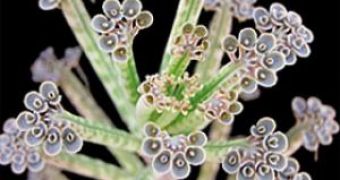Only in science fiction movies a humanoid creature can grow new individuals through its fingers. But the houseplant 'mother of thousands' (Kalanchoe diagremontiana) does it, too: a lot of tiny plantlets develop at the edges of its leaves.
"Having lost the ability to make viable seeds, the plant has shifted some of the processes that make seeds to the leaves," said Neelima Sinha, professor of plant biology at UC Davis.
There are many plants reproducing by throwing out long shoots or runners developing quickly into new individuals (like trees from the mangroves). Still, the process is much more advanced in the 'mother of thousands': the plantlets are miniversions of the adult plants that disconnect from the mother plant's feeding circulatory system and release themselves, being able to spread quickly and efficiently.
Due to this vegetative reproduction, the Kalanchoe has abandoned sexual reproduction and does not produce viable seeds, breeding just through plantlets.
Helena Garc?s, a graduate student in Sinha's laboratory, together with Sinha and a team from UC Davis and University of Lisbon, Portugal, investigated two genes, STM and LEC, in 'mother of thousands' and other related species, some of which produce seeds instead of plantlets. STM is involved in the shoot growth, while LEC controls the development of the seeds. STM activity in leaves was crucial for developing plantlets.
In the majority of the plant species, LEC is active in seeds, but in 'mother of thousands', its LEC type, named LEC1, was active also in leaves. When the team transplanted the LEC1 type into other plants, they lost the ability to produce viable seeds.
"Mother of thousands appears to have lost the ability to reproduce sexually and make seeds, but transferred at least part of the embryo-making process to the leaves to make plantlets. The findings could be useful in manipulating plant reproduction" said Sinha.

 14 DAY TRIAL //
14 DAY TRIAL //